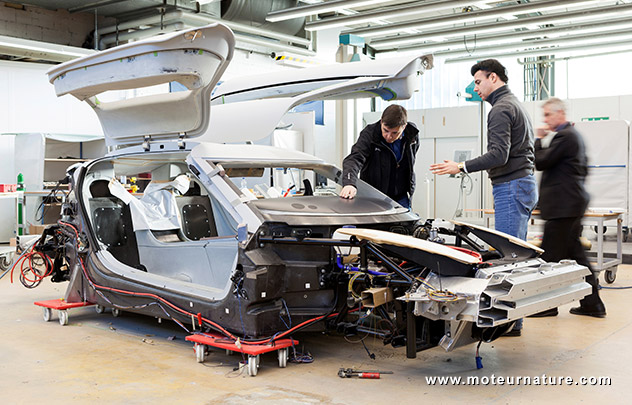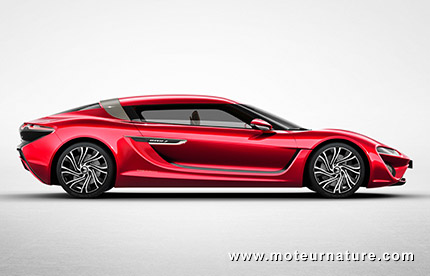... Et qui n'est pas pour me déplaire.Remundo a écrit :
Le proto a un petit côté DeLorean pour ceux qui connaissent...
Quant NanoFlowcell: la voiture à redox (oxydo-reduction) !
- Remundo
- Modérateur

- Messages : 17159
- Inscription : 15/10/07, 16:05
- Localisation : Clermont Ferrand
- x 5718
On avait déjà parlé de la Quant Nanoflowcell... Moteur Nature fait le point sur l'évolution du prototype et les perspectives de commercialisation...
Indépendamment de tous les superlatifs de ce véhicule (prix et puissance), Je reste un peu sceptique sur la fiabilité de leur zinzin.
Anecdotiquement. La ligne de la bagnole est très à mon goût. Je la trouve réussie esthétiquement.
Une boîte à 2 vitesses, c'est original sur une traction électrique.
Il y a de l'innovation dans le pack batteries (à électrolyte liquide remplaçable pour résumer). Les données techniques sont maigres sur ce sujet.
Le chaine de traction fonctionne normalement à 400 V, les ingénieurs l'ont poussé jusqu'à 735 V ! La puissance dépasse les 1000 ch. Et quand on écrase l'accélérateur, c'est un courant de 2000 (deux mille) ampères qui est envoyé au moteur. A titre de comparaison, c'est la puissance d'un grand immeuble de 60 appartements... Bref, tout est exceptionnel, et plus encore les performances puisque pour éviter tout compromis entre accélérations et vitesse de pointe, les ingénieurs ont ajouté une boite de vitesses à 2 rapports...
Indépendamment de tous les superlatifs de ce véhicule (prix et puissance), Je reste un peu sceptique sur la fiabilité de leur zinzin.
Anecdotiquement. La ligne de la bagnole est très à mon goût. Je la trouve réussie esthétiquement.
Une boîte à 2 vitesses, c'est original sur une traction électrique.
Il y a de l'innovation dans le pack batteries (à électrolyte liquide remplaçable pour résumer). Les données techniques sont maigres sur ce sujet.
0 x
- Remundo
- Modérateur

- Messages : 17159
- Inscription : 15/10/07, 16:05
- Localisation : Clermont Ferrand
- x 5718
Re: Quant NanoFlowcell: la voiture à redox (oxydo-reduction) !
j'ai récupéré un communiqué de Quant assez récent (mais beaucoup de blabla...).
Moteur Nature parle de la Quantino qui a fait ses 100 000 km.
La Quantino est une version minimaliste de démonstration.
Moteur Nature parle de la Quantino qui a fait ses 100 000 km.
La Quantino est une version minimaliste de démonstration.
0 x
-
moinsdewatt
- Econologue expert

- Messages : 5111
- Inscription : 28/09/09, 17:35
- Localisation : Isére
- x 554
Re: Quant NanoFlowcell: la voiture à redox (oxydo-reduction) !
Plus d'un an et demi plus tard.

Des nouvelles. La voiture Quantino à bien roulé. 200 000 km en route réelle plus ''150 000 km'' sur banc d'essai.
https://www.smart2zero.com/news/flow-ce ... aintenance
Ca ne dit rien sur la recyclabilité ou régeneration du fluide de la batterie.
Sur le site de Nanoflowcell

https://emagazine.nanoflowcell.com/view ... no-48volt/

Des nouvelles. La voiture Quantino à bien roulé. 200 000 km en route réelle plus ''150 000 km'' sur banc d'essai.
Flow cell propulsion car drives 350.000 km without maintenance
April 05, 2019 //By Christoph Hammerschmidt
Experimental car maker Nanoflowcell has announced that its prototype sports car Quantino 48V has covered 350.000 kilometres with practically no maintenance. What's more: the vehicles’ power conversion unit can be mass-produced at a surprisingly low price, the company reveals.
The Quantino48V has been undergoing real-life endurance testing ever since it was homologated for road use in 2016, covering more than 200,000 kilometres on the road and 150,000 kilometres on a test bed. The total mileage required the regular replacement of consumable parts such as brakes and tires, as well as a wide assortment of minor repairs. However, despite its status as a prototype vehicle, the Quantino 48V’s powertrain ran with no problems throughout the duration of the test, the company writes in a blog.
Also the Nanoflowcell – as the company has baptized the unit that converts chemical into electrical energy in the vehicle – ran reliably throughout the entire test distance without any error alert and “virtually maintenance free”. The control software for the energy management system has been updated several times to improve system efficiency. As a result of these efficiency-driven updates, the vehicle reached an average consumption of just 8 to 10 kWh per 100 km.
In the same blog post, the company for the first time provided figures as to the price and value not of the entire car, but at least of the nanoflowcell energy conversion unit as certainly a rather crucial component: The unit could be mass-produced at a price around 600 euros, the company said. Since this component largely requires no maintenance, a vehicle built on this basis could be operated at rather low maintenance costs. The company even goes so far as to guarantee a service life of 50,000 operating hours. In the case at hand, this would correspond to a driving distance of 1.25 million kilometres, far more than the service life of today's vehicles.
While the blog post provided no information whatsoever as to the begin of series production for the vehicle as such, the company said it is currently working on solutions for series production of the nanoflowcell membrane. Likewise, the volume production of the company’s secret electrolyte liquids (called bi-ION®) is being prepared.
Swiss-based company nanoflowcell is developing a sports car with a somewhat mysterious drive principle: the company uses two electrolytic liquids, the mixture of which is used as an energy source to generate electrical energy. The voltage generated in this way is fed into a low-voltage network (48V) and used for propulsion. Two predecessor versions of the Quantino 48V are said to have reached ranges of 600 and 800 kilometers respectively with one tank full - although the two tanks had a combined capacity of almost 200 litres, significantly more than the fuel tank of a conventional series vehicle.
The Quantino 48V is the world’s only long-range electric vehicle that does not work on potentially hazardous high voltages, the company claims. Instead, it runs on safe 48V. The electric system is buffered with supercaps. The energy then is converted to AC – the vehicle is driven by a single AC asynchronous motor with a maximum power of 80 kW / 108 hp. It delivers a maximum torque of 200 Nm to the rear axle.
https://www.smart2zero.com/news/flow-ce ... aintenance
Ca ne dit rien sur la recyclabilité ou régeneration du fluide de la batterie.
Sur le site de Nanoflowcell

https://emagazine.nanoflowcell.com/view ... no-48volt/
0 x
- Remundo
- Modérateur

- Messages : 17159
- Inscription : 15/10/07, 16:05
- Localisation : Clermont Ferrand
- x 5718
Re: Quant NanoFlowcell: la voiture à redox (oxydo-reduction) !
des essais qui suscitent à la fois enthousiasme et scepticisme...
le pb de la technologie des batteries à changement d'électrolyte, c'est qu'il faudrait déployer des stations service spécialisées à partir de zéro... un peu comme pour l'hydrogène d'ailleurs.
quid des coûts et de la fiabilité... tant de questions sans réponse.
d'un autre côté, on a un réseau électrique entièrement déployé, des batteries Lithium mâtures, et des possibilités d'hybridation, notamment en biocarburant, sans construire de lourdes nouvelles infrastructures.
le pb de la technologie des batteries à changement d'électrolyte, c'est qu'il faudrait déployer des stations service spécialisées à partir de zéro... un peu comme pour l'hydrogène d'ailleurs.
quid des coûts et de la fiabilité... tant de questions sans réponse.
d'un autre côté, on a un réseau électrique entièrement déployé, des batteries Lithium mâtures, et des possibilités d'hybridation, notamment en biocarburant, sans construire de lourdes nouvelles infrastructures.
0 x
-
izentrop
- Econologue expert

- Messages : 13959
- Inscription : 17/03/14, 23:42
- Localisation : picardie
- x 1587
- Contact :
Re: Quant NanoFlowcell: la voiture à redox (oxydo-reduction) !
C'est plein d’invraisemblances cette histoire, pas de brevet, pas de références scientifiques.
560 kW / 48 V incluent à un courant de 11666 A https://emagazine.nanoflowcell.com/de/d ... erbsttest/
https://emagazine.nanoflowcell.com/de/d ... erbsttest/
Bullshit https://jalopnik.com/the-supercar-that- ... 1637600538
560 kW / 48 V incluent à un courant de 11666 A
Bullshit https://jalopnik.com/the-supercar-that- ... 1637600538
0 x
Revenir vers « Transports électriques: voitures, vélos, transports collectifs, avions... »
Qui est en ligne ?
Utilisateurs parcourant ce forum : Aucun utilisateur inscrit et 118 invités

